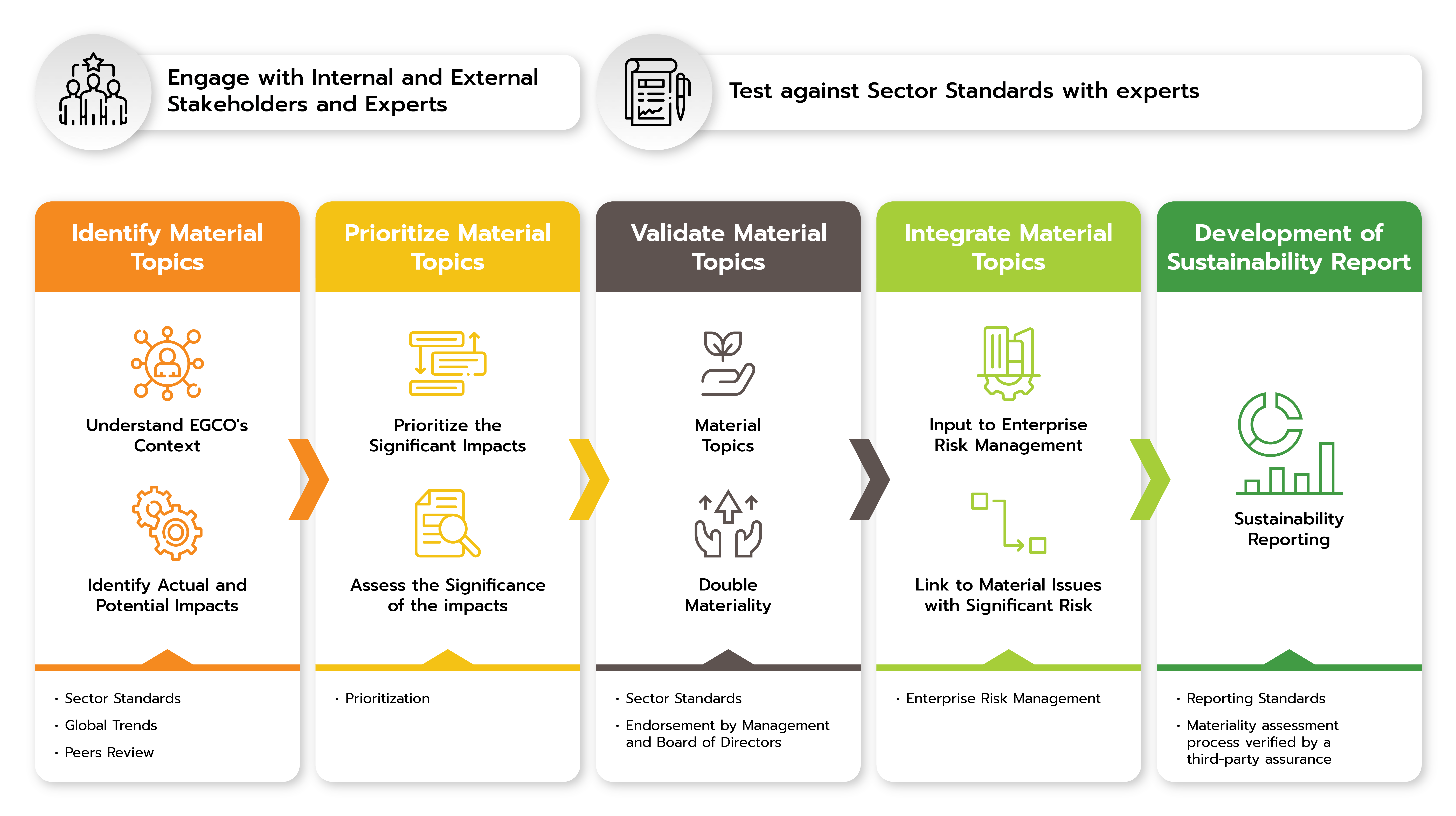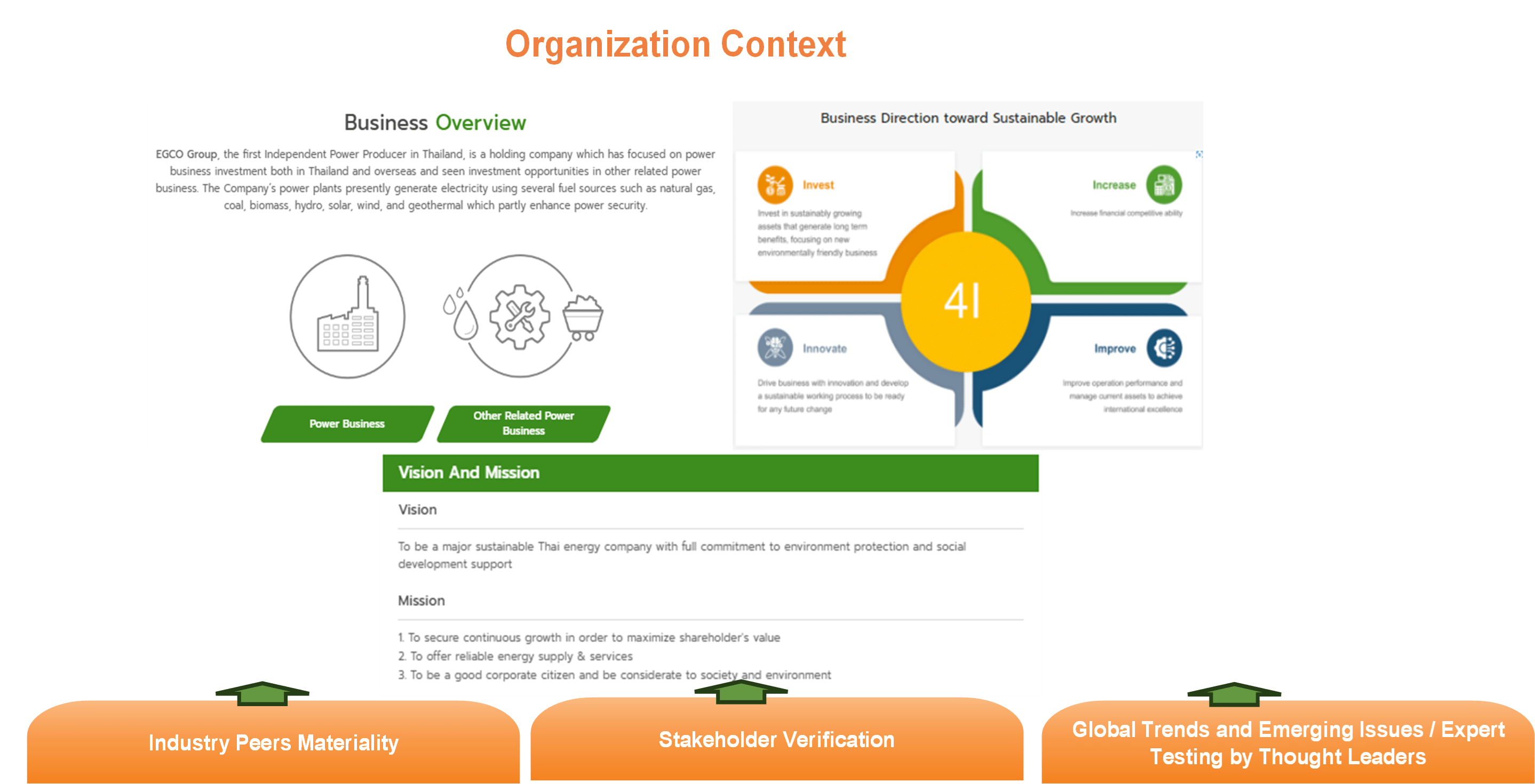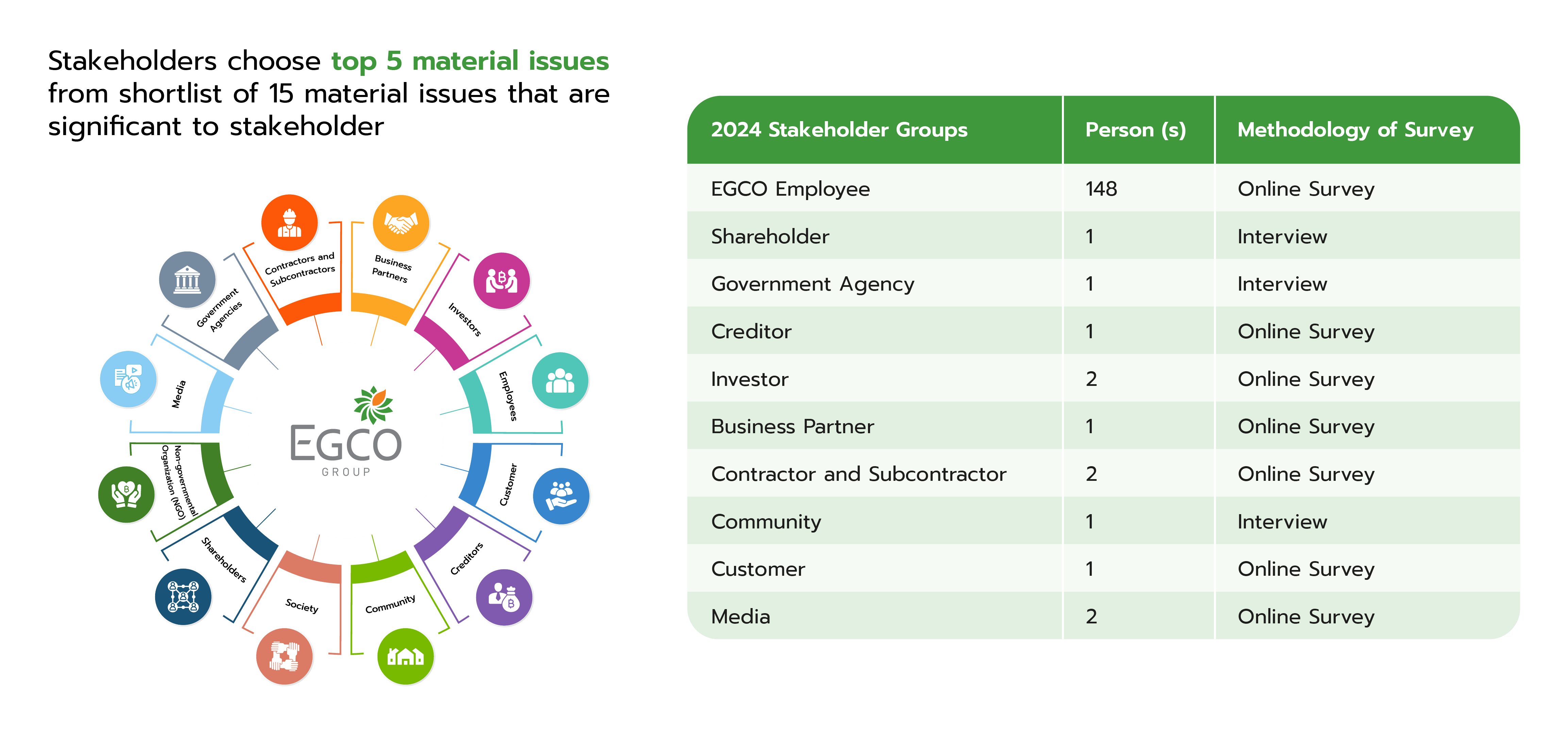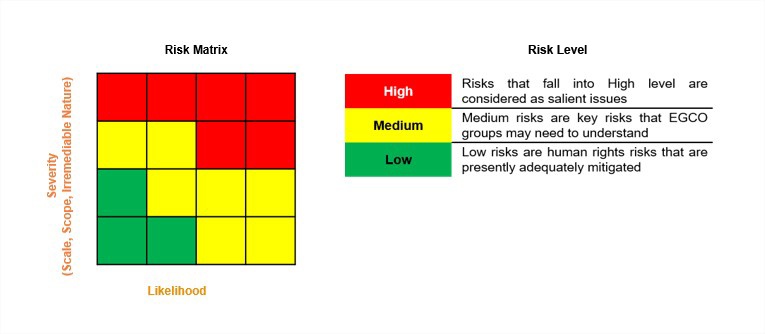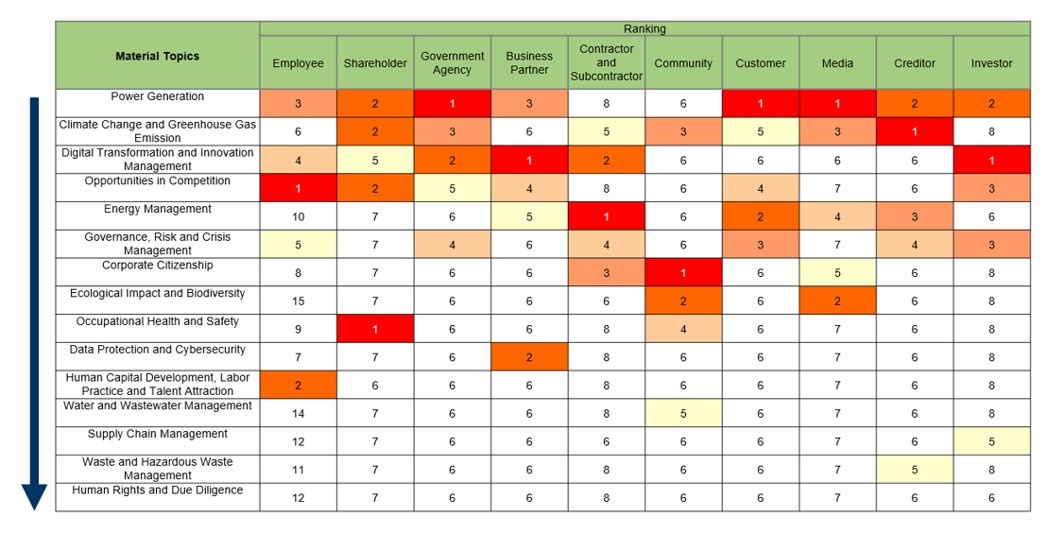Materiality Assessment
[GRI 2-1 (2021), 2-2 (2021), 2-3 (2021), GRI 2-14 (2021), 3-1 (2021), 3-2 (2021), 3-3 (2021)]
EGCO Group conducts materiality assessment annually with consideration to related internal and external operations, including potential positive and negative impacts they can have on the company, stakeholders, communities, and society throughout the organization’s value chain. EGCO Group also assesses key issues that align with stakeholders’ expectations covering economic, social, and environment (ESG) dimensions. The identified material topics are incorporated into EGCO Group’s business operations and used as a framework for reporting the annual report which covers operations for companies under EGCO Group’s operational control and joint ventures both in Thailand and overseas.
Process to determine Material Topics
List Material Topics
In 2024, EGCO Group identified 15 material topics. The identified material topics have changed from the previous year in response to global trends and the needs and expectations of stakeholders regarding EGCO Group's business operations.
EGCO Group 2024 Material topics are as follows:
| No. | Material Topics | Impact Level | |
|---|---|---|---|
| 1 | Opportunities in Competition | ECON 1 | Value Creation |
| 2 | Climate Change and Greenhouse Gas Emission | ENVI 1 | Value Creation |
| 3 | Power Generation | ECON 2 | Value Creation |
| 4 | Occupational Health and Safety | SOC 1 | Enabler |
| 5 | Digital Transformation and Innovation Management | ECON 3 | Enabler |
| 6 | Energy Management | ENVI 2 | Enabler |
| 7 | Governance, Risk and Crisis Management | ECON 4 | Foundation |
| 8 | Human Capital Development, Labor Practice and Talent Attraction | SOC 2 | Foundation |
| 9 | Corporate Citizenship | SOC 3 | Foundation |
| 10 | Supply Chain Management | ECON 5 | Foundation |
| 11 | Human Rights and Due Diligence | SOC 4 | Foundation |
| 12 | Ecological Impact and Biodiversity | ENVI 3 | Foundation |
| 13 | Data Protection and Cybersecurity | ECON 6 | Foundation |
| 14 | Water and Wastewater Management | ENVI 4 | Foundation |
| 15 | Waste and Hazardous Waste Management | ENVI 5 | Foundation |
Enhanced job creation and economic development from new sustainable energy projects
Higher energy costs during the transition period while companies invest in new technologies and infrastructure
- Strategic Risk
- Financial Risk
- Operations
- Products/Services
- Supply Chain
Short-term impact
- Raw Material Provision
- Power Generation
- System Installation and Maintenance Business Unit
- Other Relevant Power Business Units
- Products and By-products
- Supporting Activities
- Customers
- Shareholders
- Government Agencies
- Employees
- Communities
- Creditors
- Suppliers & Business Partners
- Investors
- Contractors
- Non-governmental Organizations
GRI 201: Economic Performance (2016): 201-1
For more information, please see Climate Climate Strategy and Market Opportunities Overview
One Report: Opportunities in Competition
Increased access to greener and more sustainable energy which can lead to cost savings and improved quality of life
Unable to reduce greenhouse gas emissions and contribute to climate change and loss of biodiversity
- Strategic Risk
- Operational Risk
- Financial Risk
- Operations
- Products/Services
- Supply Chain
Long-term impact
- Raw Material Provision
- Power Generation
- System Installation and Maintenance Business Unit
- Other Relevant Power Business Units
- Products and By-products
- Supporting Activities
- Customers
- Shareholders
- Government Agencies
- Employees
- Communities
- Creditors
- Suppliers & Business Partners
- Investors
- Society
- Contractors
- Media
- Non-governmental Organizations
GRI 305: Emission (2016): 305-1*, 305-2*, 305-3*, 305-7*
For more information, please see Climate Strategy and Market Opportunities Overview
One Report: Climate Change
Increased operational excellence leads to more job security and compensation for employees
Less power security for customers and reduction of job security for employees
- Operational Risk
- Operations
- Products/Services
- Supply Chain
Short-term impact
- Power Generation
- System Installation and Maintenance Business Unit
- Other Relevant Power Business Units
- Products and By-products
- Customers
- Shareholders
- Government Agencies
- Employees
- Communities
- Creditors
- Suppliers & Business Partners
- Investors
- Contractors
GRI 2: General Disclosures (2021)
For more information, please see Power Generation Stability & Capability
Power generation Impact Valuation
One Report: Power Generation
Enhance safety and well-being of employees, suppliers and contractors
Disregard of safety leads to injury or even fatality in the workplace
- Operational Risk
- Operations
- Products/Services
- Supply Chain
Short-term impact
NA
- Raw Material Provision
- Power Generation
- System Installation and Maintenance Business Unit
- Other Relevant Power Business Units
- Products and By-products
- Supporting Activities
- Customers
- Shareholders
- Employees
- Communities
- Creditors
- Suppliers & Business Partners
- Investors
- Contractors
GRI 403: Occupational Health and Safety (2018): 403-9*
For more information, please see Occupational Health and Safety Overview
Improved reliability and stability of the business due to digital transformation
Decreased competitiveness and failure to upskill employees to adapt with new technology
- Strategic Risk
- Organization Structure Risk
- Operations
- Products/Services
- Supply Chain
Medium-term impact
- Power Generation
- System Installation and Maintenance Business Unit
- Other Relevant Power Business Units
- Products and By-products
- Customers
- Employees
- Suppliers & Business Partners
- Creditors
GRI 2: General Disclosures (2021)
For more information, please see Innovation Management Overview
Increased efficiency in energy usage leads to reduced emissions
Increase in greenhouse gas emissions due to inability to manage resource efficiently
- Operational Risk
- Operations
- Products/Services
- Supply Chain
Long-term impact
- Power Generation
- System Installation and Maintenance Business Unit
- Customers
- Shareholders
- Employees
- Communities
- Contractors
GRI 302: Energy (2016):302-1*, 302-3*
For more information, please see Energy Efficiency Management
Ensure a stable and uninterrupted electricity supply with affordable energy prices
Disrupt daily life and cause financial losses due to frequent and prolonged power outages from company's failure to manage risks
- Strategic Risk
- Operational Risk
- Financial Risk
- Compliance Risk
- Organization Structure Risk
- Operations
- Products/Services
- Supply Chain
Short-term impact
- Raw Material Provision
- Power Generation
- System Installation and Maintenance Business Unit
- Other Relevant Power Business Units
- Products and By-products
- Supporting Activities
- Customers
- Shareholders
- Government Agencies
- Employees
- Communities
- Creditors
- Suppliers & Business Partners
- Investors
- Contractors
- Society
- Media
- Non-governmental Organizations
GRI 2: General Disclosures (2021)
For more information, please see Risk and Crisis Management Overview
Increased employee competency results in higher employee engagement, satisfaction, and retention in company
Decreased morale in employees and inability to retain talented people
- Organization Structure Risk
- Operations
- Products/Services
Short-term impact
NA
- Raw Material Provision
- Power Generation
- System Installation and Maintenance Business Unit
- Other Relevant Power Business Units
- Products and By-products
- Supporting Activities
- Employees
- Contractors
GRI 404: Training and Education 2016: 404-1
GRI 405: Diversity and Equal Opportunity 2016: 405-2*
For more information, please see Our Employees Overview
Enhanced quality of life of local communities by implementing responsible corporate citizenship initiatives
Insufficient attention to corporate citizenship leads to tension with community members causing conflict and possible business interruption
- Strategic Risk
- Operations
- Products/Services
Short-term impact
NA
- Raw Material Provision
- Power Generation
- System Installation and Maintenance Business Unit
- Other Relevant Power Business Units
- Supporting Activities
- Shareholders
- Employees
- Communities
- Society
- Media
- Non-governmental Organizations
GRI 413: Local Communities (2016):413-1
For more information, please see Corporate Social Responsibility Overview
One Report: Corporate Social Responsibility
Fair transactions and timely payments foster strong relationship with suppliers
Discrimination in procurement process for suppliers
- Operational Risk
- Supply Chain
Short-term impact
- Raw Material Provision
- Suppliers & Business Partners
- Contractors
GRI 2-6 Activities, value chain and other business relationships (2021)*
GRI 308: Supplier Environmental Assessment (2016): 308-1
GRI 414: Supplier Social Assessment (2016):414-1, 414-2
For more information, please see Supply Chain Management Overview
Guarantee equality in workplace where no rights are violated for all stakeholders
Violates human rights for stakeholders from operation activities
- Operational Risk
- Compliance Risk
- Operations
- Products/Services
- Supply Chain
Short-term impact
- Raw Material Provision
- Power Generation
- System Installation and Maintenance Business Unit
- Other Relevant Power Business Units
- Products and By-products
- Supporting Activities
- Customers
- Shareholders
- Government Agencies
- Employees
- Communities
- Creditors
- Suppliers & Business Partners
- Investors
- Society
- Contractors
- Media
- Non-governmental Organizations
GRI 2: General Disclosures (2021)
For more information, please see Human Rights Overview
Preserve ecosystems, protect endangered species and maintain ecological balance by using environmentally friendly technology to conserve biodiversity
Inefficient management on biodiversity leads to increased pollution and damage to the ecosystem and public health problems
- Strategic Risk
- Operational Risk
- Operations
- Supply Chain
Long-term impact
NA
- Raw Material Provision
- Power Generation
- System Installation and Maintenance Business Unit
- Other Relevant Power Business Units
- Products and By-products
- Supporting Activities
- Customers
- Employees
- Communities
- Suppliers & Business Partners
- Society
- Contractors
- Non-governmental Organizations
GRI 304: Biodiversity 2016: 304-1 304-2 304-3
For more information, please see Biodiversity
Guarantee safety of sensitive data
Personal Information is leaked and decrease in employee and customer trust
- Operational Risk
- Operations
- Products/Services
- Supply Chain
Short-term impact
NA
- Raw Material Provision
- Power Generation
- System Installation and Maintenance Business Unit
- Other Relevant Power Business Units
- Products and By-products
- Supporting Activities
- Customers
- Shareholders
- Government Agencies
- Employees
- Creditors
- Suppliers & Business Partners
- Investors
- Contractors
GRI 418: Customer Privacy (2016): 418-1*
For more information, please see Privacy Protection and Cybersecurity Overview
Guarantee water security for the community
Contribute to water scarcity and pollution which creates conflict with the surrounding community
- Operational Risk
- Operations
- Products/Services
- Supply Chain
Long-term impact
NA
- Power Generation
- System Installation and Maintenance Business Unit
- Other Relevant Power Business Units
- Products and By-products
- Employees
- Communities
- Suppliers & Business Partners
- Society
- Contractors
GRI 303: Water and effluents (2018): 303-3*, 303-4*, 303-5*
For more information, please see Sustainable Water
Improved public health and safety from less exposure to hazardous substances and pollution
Create excessive waste pollution and disturb the surrounding community
- Operational Risk
- Operations
- Products/Services
- Supply Chain
Short-term impact
NA
- Power Generation
- System Installation and Maintenance Business Unit
- Other Relevant Power Business Units
- Products and By-products
- Customers
- Communities
- Suppliers & Business Partners
- Society
- Contractors
GRI 306: Waste (2020):306-3*, 306-4*, 306-5*
GRI 306 Effluents and Waste (2016):306-3*
For more information, please see Waste Management
